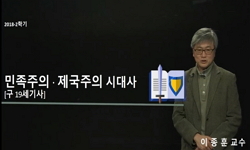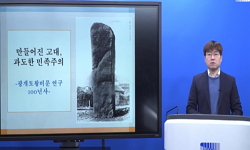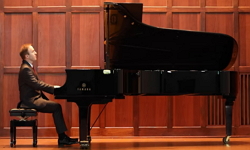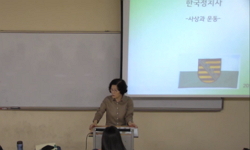20세기 아르헨티나 작곡가인 알베르토 히나스테라(Alberto Ginastera 1916-1983)는 남미의 대표적인 작곡가로서 민족주의적 성향이 그의 작품에 두드러지게 나타난다. 그의 작품은 시기별로 세가지 ...
http://chineseinput.net/에서 pinyin(병음)방식으로 중국어를 변환할 수 있습니다.
변환된 중국어를 복사하여 사용하시면 됩니다.
- 中文 을 입력하시려면 zhongwen을 입력하시고 space를누르시면됩니다.
- 北京 을 입력하시려면 beijing을 입력하시고 space를 누르시면 됩니다.
https://www.riss.kr/link?id=T9339013
- 저자
-
발행사항
용인 : 명지대학교 대학원, 2003
- 학위논문사항
-
발행연도
2003
-
작성언어
한국어
- 주제어
-
KDC
676.2 판사항(4)
-
발행국(도시)
경기도
-
형태사항
iii, 77p. : 삽도,악보 ; 27cm
-
일반주기명
참고문헌: p. 72-74
- 소장기관
-
0
상세조회 -
0
다운로드
부가정보
국문 초록 (Abstract)
20세기 아르헨티나 작곡가인 알베르토 히나스테라(Alberto Ginastera 1916-1983)는 남미의 대표적인 작곡가로서 민족주의적 성향이 그의 작품에 두드러지게 나타난다. 그의 작품은 시기별로 세가지 음악 성향, 즉 객관적 민족주의, 주관적 민족주의, 신표현주의로 나눌 수 있는데 그 중 세개의 피아노 소나타는 1947년 이후에 쓰여진 것들로 객관적 민족주의와 신표현주의 성향이 두드러진다. 그의 작품에는 잉카 음악, 스페인 음악, 아프리카 음악의 세 가지 민속적인 요소들이 사용되었고 그 안에서 현대적인 요소들을 사용하였다. 또한 후기로 갈수록 현대적인 기법들이 더욱더 많이 사용되었고, 민속적인 요소들로 그 자체로 쓰이는 것이 아니라 현대적인 기법과 조화를 이루어 사용되었다.
소나타 3곡에 사용한 민속적 요소와 현대적 기법들을 정리해 보면 다음과 같다.
『소나타 1번』은 비교적 전통적 형식을 취하였으며 현대적 기법(12음렬, 복화음 등)들보다 민속적 요소(크레욜 민요, 말람보 리듬, 오스티나토 등)의 사용이 훨씬 더 두드러졌다.
『소나타 2번』은 3악장 형식의 소나타로 전통적인 기법을 탈피했다. 세 부분 형식의 1악장과 마디의 구분이 없는 2악장, 피아노의 타악기적 요소를 부각시킨 3악장은 민속적 요소(크레욜 민요, 3도 병진행, 카르나발리토 리듬 등)를 바탕으로 현대적인 기법들(복조, 온음관계 클러스터 코드, 변박자 등)이 많이 사용되었다.
『소나타 3번』은 단악장 형식으로 전통적인 소나타의 의미가 아닌 소나타의 원래 뜻-'기악곡'의 의미로 '노래하다'인 '칸타타(cantata)'에 반대되는 말-의 의미로 쓰였다고 볼 수 있다. 코다를 지닌 2부분 형식으로 두 개의 모티브를 곡 전체에 사용하였고 선율적 요소가 거의 나타나지 않는다. 처음부터 마지막까지 최대의 음향을 사용하였으며 5음 음계를 클러스터 코드로 사용하는 등 민속적 요소들을 현대적인 기법으로 사용하였다.
3개의 소나타에는 오스티나토, 동음연타, 크레욜 민요, 헤미올라 리듬을 가지고 있는 말람보 리듬 등의 민속적인 요소들이 공통적으로 사용되었다. 이러한 요소들은 현대적 기법과 균형있게 결합되어 독특한 국민주의적 음악양식을 보여주고 있다.
다국어 초록 (Multilingual Abstract)
Alberto Ginastera (1916-1983) is one of the most representative Argentine composer of the twentieth century, who has explicitly revealed nationalistic tendency in his realm of composition. He devoted himself to the musical works following in three dis...
Alberto Ginastera (1916-1983) is one of the most representative Argentine composer of the twentieth century, who has explicitly revealed nationalistic tendency in his realm of composition. He devoted himself to the musical works following in three distinctive periodical phases ; (1) objective nationalism, (2) subjective nationalism, and (3) neo-expressionism. Ginastera's three piano sonatas were composed after 1947, which had strong inclination of objective nationalism and neo-expressionism. His works were comprised of Incan, Spanish, and African musical folk traditions, coordinated with contemporary methods. In fact, the number of incidence importing modern techniques gradually increased in his later works. Meanwhile, folk resources well-harmonized with other contemporary elements, since they were rarely applied to his piece without necessary transformation.
In Ginastera's three sonatas, his musical grammar - derived from both folk and modern source, can be characterized as follows:
1. Sonata No. 1 is constructed with traditional structure, more inclined to folk elements by using Creole folk song, Malambo rhythm, and ostinato, rather than contemporary methods such as twelve-tone row or compound harmony.
2. Sonata No. 2 is a three-movement-sonata, which evaded from the traditional methods. First movement is in a tertiary form; second movement has no measure divisions; and third movement has featured piano's percussional trait. Each movement relies upon modern methods(using compound tonality, cluster chords in the whole-tone relation, and irregular time) in the basis of folk elements like Creole folk song, third-degree parallel progression, Carnavalito, and folk rhythm.
3. Sonata No. 3 is composed of single movement, not in the sense of sonata's conventional meaning. Instead, it represents its original meaning of instrumental work, contrary to the word 'cantata' which means singing. This piece, binary form with coda, uses two motives throughout the work, and any melodic factor can hardly be detected. Maximum acoustical effect has been performed from the beginning till the end. Also, it implies modern usage of folk elements, such as pentatonic scale being applied to cluster chords.
Traditional folk characteristics commonly appear in all of three sonatas, continuously repeating the same note, and containing ostinato, Creole folk song, and Malambo rhythm which involves hemiola. These ethnic folk resources are harmonized with contemporary methods, engendering a unique nationalistic music style.
목차 (Table of Contents)
- 목차
- 표목차 = ⅰ
- 국문초록 = ⅱ
- Ⅰ. 서론 = 1
- Ⅱ . 히나스테라(Alberto Ginastera)의 음악양식 = 3
- 목차
- 표목차 = ⅰ
- 국문초록 = ⅱ
- Ⅰ. 서론 = 1
- Ⅱ . 히나스테라(Alberto Ginastera)의 음악양식 = 3
- 1. 생애 및 음악양식 = 3
- 1) 히나스데라의 생애 = 3
- 2) 음악적 스타일 = 5
- 2. 피아노 음악 = 10
- Ⅲ. 작품분석 = 13
- 1. Sonata No.1 Op.22 = 13
- 1) 1악장 Allegro marcasto = 13
- 2) 2악장 Presto misterioso = 22
- 3) 3악장 Adagio molto appassionato = 29
- 4) 4악장 Ruvido ed ostinato = 33
- 2. Sonata No.2 Op.53 = 39
- 1) 1악장 Allegramente = 39
- 2) 2악장 Adagio sereno = 46
- 3) 3악장 = 53
- 3. Sonata No.3 Op.55 = 60
- Ⅳ. 결론 = 69
- Ⅴ. 참고문헌 = 72
- ABSTRACT = 75












